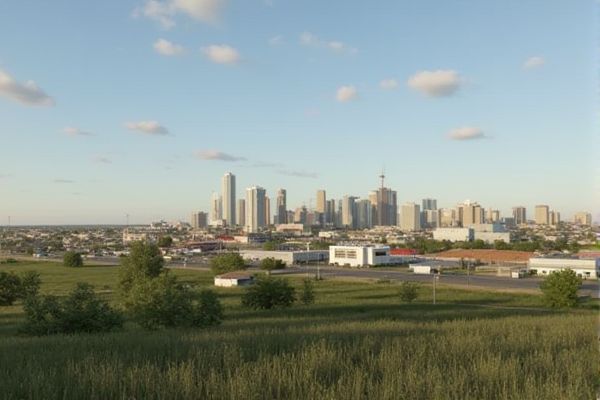
Transportation and commuting in North Dakota: Limited public transportation options. Popularity of personal vehicle usage. Significant rural road networks. Snow and ice driving conditions. Interstate Highway coverage. Reliable rideshare services. Seasonal road construction projects. Long commute times in rural areas. Bike-friendly communities. Amtrak service availability.
Limited public transportation options.
In rural North Dakota, public transportation options are limited but available through approximately 32 bus programs, including demand response, dial-a-ride, and intercity services, which help connect residents to regional hubs and essential services. Though the frequency and availability can be restricted due to the dispersed population, these services play a crucial role in maintaining connectivity. For more detailed information on these services, you can visit the Statewide Transit page, which outlines the various programs and their operational details.
Popularity of personal vehicle usage.
In North Dakota, personal vehicles are the primary mode of transportation, with approximately 93.4% of the state's housing units possessing a vehicle, and 91.2% of all trips made in personal automobiles. This high reliance on personal vehicles is driven by the state's sparse population and limited public transportation options, especially in rural areas. For more detailed information, resources are available on the Upper Great Plains Transportation Institute's website.
Significant rural road networks.
North Dakota has an extensive rural road network, with the county/township road system including about 6,600 miles of paved roads, 59,000 miles of gravel roads, and 32,000 miles of unsurfaced roads. The local roadway network is crucial for the state's economy, connecting rural communities to urban areas and facilitating the movement of people, goods, and services. For further details on the management and maintenance of these roads, you can refer to the North Dakota County Road Bridge Handbook, which provides a comprehensive overview of the strategies employed to sustain and enhance this vital infrastructure.
Snow and ice driving conditions.
In North Dakota, winter driving conditions are hazardous due to significant snowfall, icy roads, and black ice. The North Dakota Department of Transportation (NDDOT) provides updated road conditions through the 511 system and utilizes various tools like snowplows, snow blowers, and ice-melting materials to maintain road safety. Motorists are advised to check road conditions regularly, especially during Travel Alerts and No Travel Advisories, and to be cautious of changing weather conditions.
Interstate Highway coverage.
North Dakota has several Interstate Highways, including I-29, I-94, and the short I-194, which are part of the Dwight D. Eisenhower National System of Interstate and Defense Highways. These highways connect key cities and borders, such as Fargo, Bismarck, and the Canadian border, facilitating both local and interstate travel. For a detailed list, you can visit the List of Interstate Highways in North Dakota on Wikipedia.
Reliable rideshare services.
Reliable rideshare services in North Dakota, particularly in Bismarck, are limited; Uber and Lyft are available, but their services are not as extensive as in other areas, and Taxi Services are currently not available.
Seasonal road construction projects.
This year's construction season in North Dakota involves approximately $580 million in projects to enhance the state highway system, including major projects such as the Grant Marsh Bridge deck overlay, Interstate 94 Exit 161 interchange reconstruction, and U.S. Highway 85 four-lane project, with a strong emphasis on work zone safety and public awareness campaigns. To stay updated on these significant improvements, the North Dakota Department of Transportation provides comprehensive details on their website, which extensively covers the range of projects and safety measures being implemented.
Long commute times in rural areas.
In North Dakota, rural areas such as Renville County face notably long commute times, with an average commute of 37.9 minutes and 20.9% of drivers experiencing commutes over an hour, highlighting the challenges of commuting in these regions. These extensive journey times underscore the story of North Dakota's most grueling commutes, exemplified on the Keyz Radio website. Such conditions pose significant challenges for residents, as they navigate these extended daily travels.
Bike-friendly communities.
Bismarck and Mandan have been designated as a Bicycle Friendly Community, recognizing their efforts in providing trails, bike lanes, and sidewalks that connect the communities, making them conducive for cycling and other forms of active transportation. For more information on this initiative, you can visit the official website of Bicycle Friendly Community, which highlights their commitment to promoting a healthy and sustainable mode of transportation.
Amtrak service availability.
In North Dakota, Amtrak's Empire Builder service is the primary route, running from Chicago to Seattle with stops in several North Dakota cities, including Minot, Williston, Stanley, Rugby, Devils Lake, Grand Forks, and Fargo. A new plan to reinstate the southern North Coast Hiawatha route, which last operated in 1975, is in the initial stages and would provide additional service to communities like Jamestown, Bismarck, Mandan, and Dickinson. This development was recently discussed on the Minot Daily News website, confirming that it will not affect the Empire Builder service.
